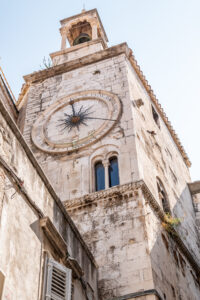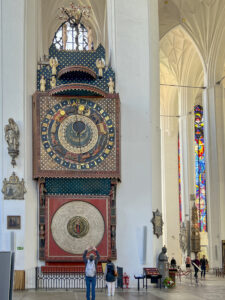It’s approaching 3 o’clock in the afternoon in Bern. Jutting slightly into view at the end of the uneven stone street in the Swiss city’s historic heart stands a medieval tower adorned with the famous 15th-century “time bell,” Zytglogge. A small gathering forms at the tower’s base as the clock prepares to announce the hour — an event heralded by the crowing of a golden rooster, music and a dance of mechanical figures that include an assortment of jolly bears.
The tower’s facade also bears the celestially themed Astrolabium, an astronomical calendar offering its own mysterious assessment of when and where we are; one less tied to a human construct of daily hours and suggestive of a grander scale of passage through the immediate cosmos, played out with constellations, planets, the moon and the sun.
The music fades. Its task completed, Zytglogge falls silent. A short walk away, down Kramgasse, lies the apartment where Albert Einstein lived while developing his theories of time and space. The clock was a familiar — and pivotal — landmark to him.

© Debra Bokur
I reach down, my fingers touching the worn copy of Einstein’s Dreams stuffed into my day bag; in it, each short chapter by author Alan Lightman posits a different vision of how time might exist. Lightman’s tale explores how Einstein might have imagined time while Zytglogge played out its own form of calculations, the manmade weights and gears grinding out a soundtrack to the scientist’s theoretical leaps.
At noon a few days later in Vienna, I make my way to Hoher Markt, a central street spanned by a bridge connected to the former Anker Insurance Co. building, now part of the international insurance group Helvetia. On the face of the bridge is Ankeruhr, or Anker Clock. Like the device in Bern, Ankeruhr is adorned with mechanical figures, created to parade across the clockface by artist and sculptor Franz Matsch.
An expert on all things Ankeruhr, Gerald Sabath of Facility Management Helvetia Austria tells me a chilling story that perfectly illustrates the importance of a single moment: To hide from the Nazis, Holocaust survivor (and later journalist, author and singer) Inge Ginsberg sheltered, successfully, for a single night within the clock. Its purpose for existing, however, presents a lesson in marketing ingenuity.

Ningyocho, Tokyo © Crisfotolux | Dreamstime.com
“When Anker Versicherung [Anker Insurance] commissioned Matsch to plan and design the Anker Clock, the intention was very clear,” Sabath explained. “They wanted to draw the attention of passersby to the transience of life and subliminally convey to them the need to take precautions — precautions in the form of insurance.
This message can be clearly seen in the design elements: On the left side of the roof is a child playing with a butterfly, on the right is Death holding an hourglass. In between is a smiling sun and a scale representing precious time. Matsch not only created one of Vienna’s best-known landmarks but also a timeless ‘advertising medium’ of inestimable value.”
He told me more, explaining the clock, known colloquially as the “Old Lady,” doesn’t necessarily keep perfect time and often struggles during especially hot weather. Understandable, according to Sabath, who added each of the clock’s 12 figures weighs up to 300 kilograms, and it is still driven by the original chain from 1914.
“Despite regular maintenance, the Anker Clock is therefore never completely on time,” he said. “As a Swiss-orientated company with a strong sense of punctuality, we find this particularly amusing.”

Dubrovnik Bell Tower © Mirko Kuzmanovic | Dreamstime.com
The next day I nearly miss my train to Munich; the irony that I’ve failed to charge my solar wristwatch not lost on me. In Marienplatz on the front of New City Hall, the famous carillon known as the Glockenspiel prepares to mark 5 p.m. As with Zytglogge, the elaborate performance that accompanies the turning of the hour includes a golden bird. Several hundred years younger than the clock in Bern, the show offered by Glockenspiel features a jousting match and a dance by barrel makers. Music provided by 43 bells ceases as the golden bird appears and chirps three times.
On the way to Prague I try to imagine, as did Lightman’s narrator, what it would mean if time was a sense. Too tired to work it out, I sleep on the train and emerge at the station feeling disoriented. In Old Town Square, Old Town Hall is home to the marvelous Prague Orloj clock. It’s old, dating to 1410, when it was created by imperial clockmaker Mikuláš of Kadaň. Damaged, repaired and revived, the clock features an intricate astrolabe and is what I imagine a magical timepiece from a fantasy world might look like: a wondrous astronomical dial with the sun and moon; a zodiac wheel; and figures of saints, stars and golden numerals.
The world is rife with such magnificent tributes to timekeeping. There are fantastical mechanical clocks in multiple locations throughout Italy and France; among those in other countries are the remarkable Rådhus astronomical clock on Oslo’s City Hall building; Aimmer tower clock in Lier, Belgium; Dubrovnik’s moon ball belltower clock in Croatia; Lund clock in Sweden; Gdańsk clock and Wrocław’s moon phase clock in Poland; Latvia’s blue-and-golden Riga clock; and lovely Stará Bystrica in Slovakia. The remarkable clock affixed to the exterior of the Grandmaster’s Palace in Valletta, Malta, sounds when four mechanical figures strike the clock’s bells.
Other cities can also lay claim to marvelous mechanical devices displayed in or on towers, city buildings, churches and other places of worship. In Georgia, the Batumi astronomical clock peers out over Europe Square from its prominent position on what was once the National Bank Building. The landmark Kremlin Clock on Spasskaya Tower in Moscow is the fifth in a series that has kept time and announced the New Year for the city’s residents since 1491. The current clock, installed in 1852, is a mass of intricate gears, weights and enormous bells.
In a section of Tokyo once known for its puppet theaters, Ningyōchō Mechanical Clock Towers each offer viewers a separate experience of storytelling through animated puppet figures. In Kyiv, a facade of Holy Trinity Monastery houses a beautiful clock with a legend linking it to French novelist Honoré de Balzac, said to have made the difficult journey from Paris with the clock in tow to present to his wife, Evelina Hanska.

St. Mary’s Basilica in Gdańsk, Poland © Ryszard Parys | Dreamstime.com
The last leg of my journey brings me to England’s historic town of Salisbury. Salisbury Cathedral’s faceless medieval clock is believed to be the oldest working mechanical clock in the world. I stand before it in the cathedral’s cool stone interior, trying to work out what all the gears and levers are meant to do. Lost for years, it was found in 1928 and eventually restored.
Emily Naish, Salisbury Cathedral archivist, provided some context. A document in the Cathedral’s archive, she told me, indicates it existed in 1386 but it could be older.
“Bishop Erghum ordered the clock to be made by three clockmakers from Delft in the Netherlands,” said Naish. “The clock is of exceptional horological importance, representing one of the few surviving examples of medieval clock-making. Originally, it was housed in a separate massive belltower in the Cathedral Close, but when the belltower was demolished in the 1790s, the clock was moved into the Cathedral’s tower, where it remained in operation until the 19th century. In the 20th century it was moved down from the Cathedral tower to the ground floor of the Cathedral and restored. The fact that it has survived and is still working today is remarkable.”
Outside in the crisp air, I drift toward a bench facing the cathedral. Weary, I pull out the little paperback by Lightman and flip to the chapter titled “14 May 1905.” A traveler has approached a place where all time stands still, and “pendulums of clocks float mid-swing.” I want to catch a cab and head to my hotel, where it’s warm and I can fall asleep without setting an alarm. But I only have one more day before boarding the long flight home, and feel my time here slipping away.
Or is it? Time’s speed of passage is proportional, surely, dependent upon a particular state of mind. Is it also linear, and are we really moving to a point ahead, or is it possible time is something that winds through space with the same endless circular shape as a clock’s face?
Whatever the true nature of time, clocks provide a way to measure the seconds, minutes and hours of our own individual existences, as well as larger moments of history. Perhaps the visibility and tangible beauty of intricately crafted mechanical clocks remind those who stroll past and glance up in awe — or sit in contemplation — about time’s fleeting and priceless nature and, in the process, help us appreciate more deeply our own brief moments.
Read This Next

Introducing
FX Excursions
FX Excursions offers the chance for once-in-a-lifetime experiences in destinations around the world.
#globility
Insta FeedDaily
Dec 23, 2024Fontainebleau Las Vegas Welcomes Bottega Veneta, Gucci
Fontainebleau Las Vegas welcomes two world-renowned fashion brands to its luxury resort and casino: Bottega Veneta and Gucci.
Sponsored Content
Sailing the Ionian Sea: Explore Greece’s Nautical Gems
Sailing the Ionian Sea is an enchanting way to experience Greece's breathtaking islands and pristine waters. Known for its favorable winds, calm seas and stunning landscapes, the Ionian Sea offers a paradise for both experienced sailors and those looking to explore for the first time. From lively beaches to secluded bays, these waters have something for every traveler seeking adventure and relaxation.
Daily
Dec 23, 2024New 19-Story, Dual-Branded Moxy/AC Hotel Comes to Dallas in 2026
A new 19-story, dual-branded hotel development featuring Marriott brands AC Hotel and Moxy Hotel is expected to open in summer 2026 in the heart of Uptown Dallas. The Peachtree Group project will bring 264 upscale hotel rooms; modern amenities; and unique food, beverage and retail venues to the bustling McKinney Avenue corridor. The much-anticipated project promises to elevate the city's hospitality scene.
Daily
Dec 23, 2024Perfect Moment, Goldener Hirsch Launch Après Pop-Up in Park City, Utah
Goldener Hirsh, Auberge Resorts Collection, a mid-mountain resort in Deer Valley, recently announced a winter collaboration with Perfect Moment Ltd., the high-performance, luxury skiwear and lifestyle brand. Through this partnership, these two brands create a new winter experience to take over Goldener Hirsch’s seasonal Après Chalet.
Sponsored Content
United Airlines First to Purchase Sustainable Aviation Fuel for ORD
Chicago O’Hare International Airport will soon receive sustainable aviation fuel, all thanks to United Airlines, which became the first airline to purchase SAF for use at the airport, one of the largest in the United States. Neste, a producer of SAF, will provide up to 1 million gallons of its Neste MY Sustainable Aviation Fuel. The first supply arrived in August.
Slideshow
Dec 23, 20246 North American Ski Destinations to Add to Your Travel List
It’s time to start dreaming of your next trip. Here’s some destination inspiration for you. Take a visual journey through these North American ski destinations with us.
Tauck to Launch New Riverboats in France
December 2024
Dec 22, 2024Finnair Boosts U.S. Schedule to Finland
Airlines
Dec 21, 2024Last-Minute Holiday Happenings at Sofitel New York
Daily
Dec 20, 2024Daily
Dec 19, 2024Oetker Collection to Open Hotel in St. Tropez in 2027
Oetker Collection recently announced the brand’s upcoming debut in St. Tropez, France. The yet-unnamed property will open in 2027. This news follows the recent opening of Hotel La Palma in Capri, Italy, and the imminent debut of The Vineta Hotel in Palm Beach, Florida.
Sponsored Content
Experience Next-Level Travel with Condor Airlines’ New A330neo Fleet
Condor Airlines completely renewed its long-haul fleet, featuring its new Airbus A330neo. Designed to elevate your travel experience, the A330neo is equipped with cutting-edge technology and offers unrivaled comfort, ensuring an exceptional journey for every passenger. With its striking signature striped livery, the A330neo not only promises a memorable flight but also enhances the start of your vacation from the moment you step aboard.
Daily
Dec 19, 2024British Airways Unveils Brand-New First Class
British Airways recently revealed its brand-new first-class cabin design, reflecting modern British luxury travel. As part of the airline’s Airbus A380 retrofit plans, the new cabin will officially debut in mid-2026.
ShareThis